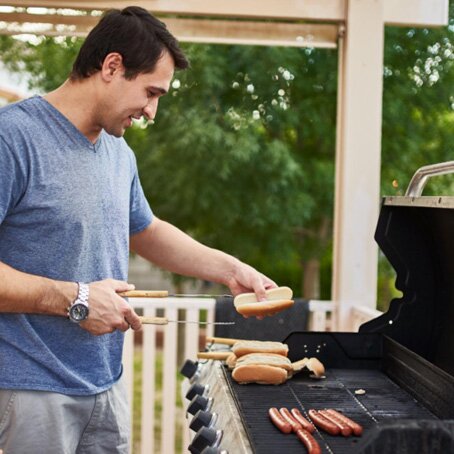Outdoor Gas Grill Cleaning and Safety Tips
5/24/2024

For most of us, the thought of cleaning an outdoor natural gas grill doesn’t exactly inspire warm fuzzy feelings. But it’s important for a number of reasons. Regular cleaning and maintenance remove food particles and grease that can harbor harmful bacteria or cause flare ups that burn food or cause injury. Regular care also helps ensure more even cooking, better tasting food, an extended lifespan of your grill and less natural gas use. Let’s take a look at some outdoor gas grill cleaning and safety tips.
How often should I clean my natural gas grill?
For the best performance and safety, it’s good to clean your grill regularly. After each use, be sure to scrub the grates with a grill brush to remove food particles and grease. And if you use your grill frequently, be sure to run the grill on high for about 15 minutes once a week to burn off excess gunk. Deep cleaning should be carried out about once or twice a year, depending on your level of use.
What do I need to clean my natural gas grill?
? Grill brush
? Bamboo skewer, toothpick, or paperclip
? Bucket of soapy water
? Bucket to catch debris
? Disposable sponge
? Towel or rag
? Bottle brush or wire coat hanger (optional)
? Steel wool pads (optional)
? Wet-dry vac (optional)
How do I deep clean my natural gas grill?
- Let the grill run on high heat for 5 to 10 minutes. After the grill is hot, turn off the gas and scrape the grate with your brush to remove food particles.
- Once the grill is completely cool, remove the grates and begin scrubbing them with your brush and soapy water. NOTE: Avoid using harsh chemicals to clean the inside of your grill. If soapy water isn’t enough, consider a homemade solution of water, vinegar and baking soda, or try scrubbing the inside with steel wool.
- Check under the grill lid, too, as this is an area that often needs scrubbing to remove grease and other debris that may have collected there.
- Next, check your burner tubes. Clogged or corroded burners can prevent flames from cooking evenly. With the gas or tank turned off, remove the cooking grates and heat deflector plates. Clean off any spills on the burner tubes with a wire brush. Then, clear any blocked holes using a toothpick, skewer or the end of a paper clip. You can also remove the tubes and run a bottle brush or straightened wire coat hanger through the center to loosen any remaining debris.
- Use your soapy water and sponge and give the heat deflector plates a thorough scrub. You'll be surprised at the difference after all that grime comes off. If you've removed your burner tubes, you can wash those in soapy water as well—or just use a damp sponge or cloth to wipe them clean. Make sure to thoroughly towel dry the tubes and gas ports before putting them back on the grill.
- Because most grime ends up at the bottom of the grill, you'll want to spend some time there, too, scrubbing with your grill brush. Some grills have removable bottom trays that slide out, making this part of the job easier. Scoop the debris into your bucket or use a wet-dry vac to remove it.
- Give the outside of your grill a wipe-down using some cleaning solution and a paper towel. Don't use scouring pads on the outside of the grill since those can leave scratch marks (especially on stainless steel). You can also wipe down the storage area underneath the grill.
- Finally, heat the grill again on high for around 10 or 15 minutes to evaporate any remaining moisture or cleaning solution. Once it's cool, put the cover on and you're ready for another successful grilling season!
PRO TIP: Apply a thin layer of vegetable oil to the grill grates before and after each use. This helps prevent rust and keeps food from sticking.
What about maintenance on my natural gas grill?
Besides regular cleaning, there are a few things you should do to keep your grill in top condition and to maximize its lifespan.
First, keep the grill covered when it's not in use. It may seem like a no-brainer, but this prevents it from rusting and helps keep it clean. If your grill isn't sheltered, it's worth investing in a cover.
You'll also want to check the gas line monthly. Simply run some soapy water along the gas line and connections while the gas is turned on. If any bubbles form, that indicates a leak. You'll want to tighten the connection or replace the line. In fact, you’ll want to replace any parts that seem to be worn or malfunctioning. If in doubt, check your owner’s manual or call the manufacturer.
Looking for more helpful information on natural gas appliances and safety from Gas South, your experts in everything natural gas? Use the links below!
 Help
Help Giving Back
Giving Back My Account
My Account Sign Up
Sign Up











